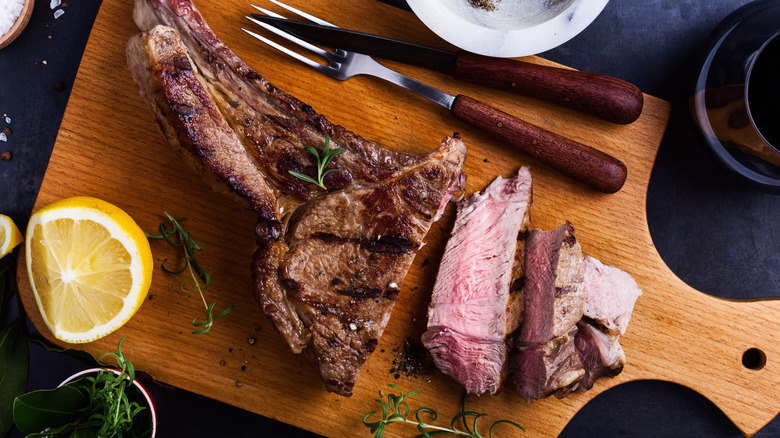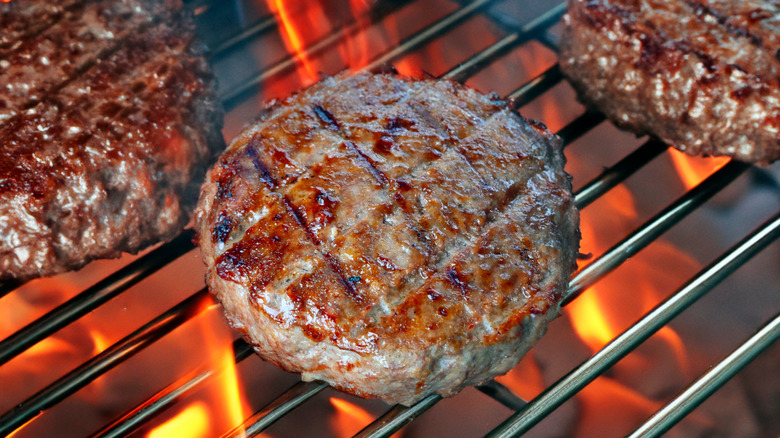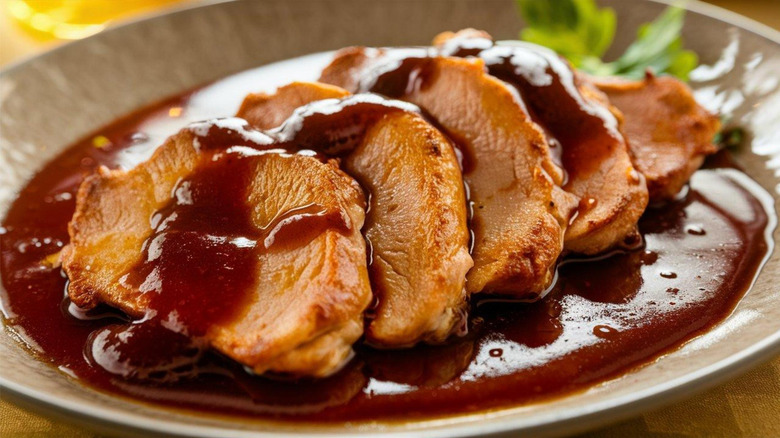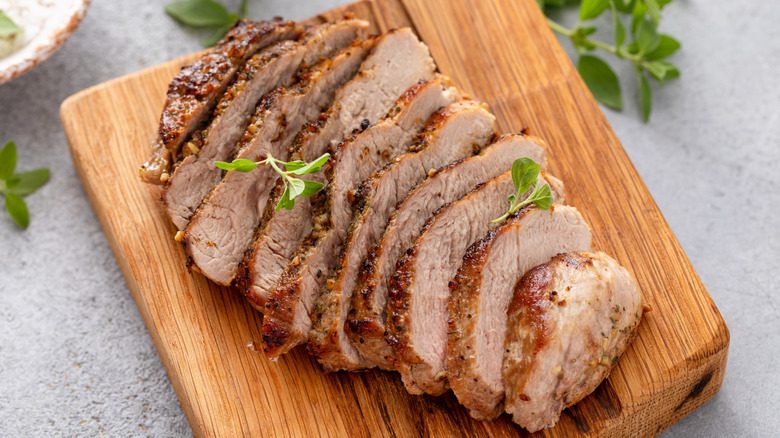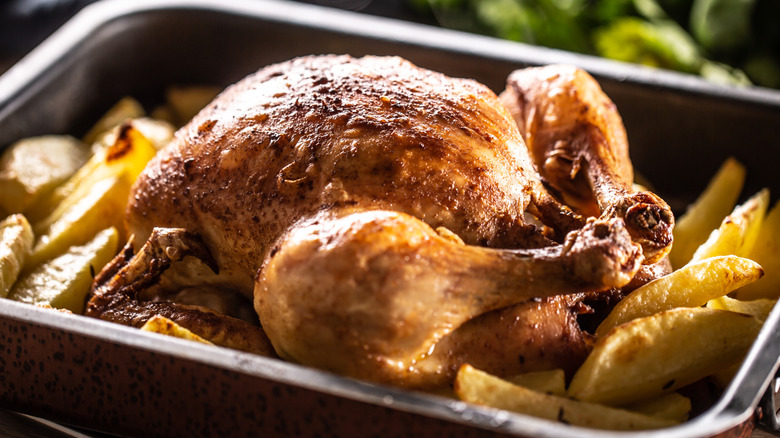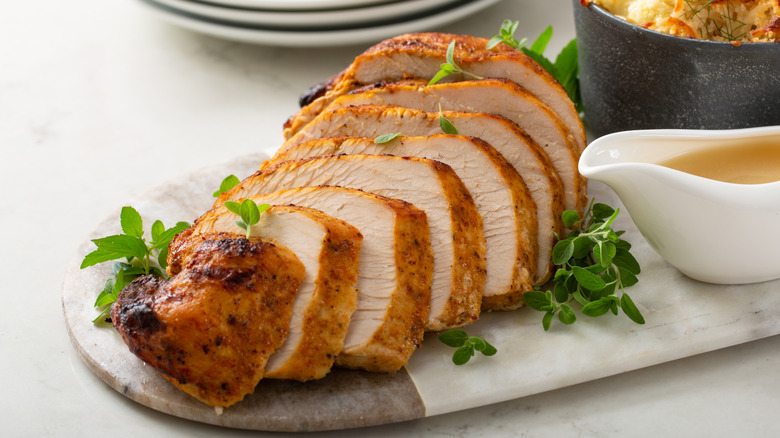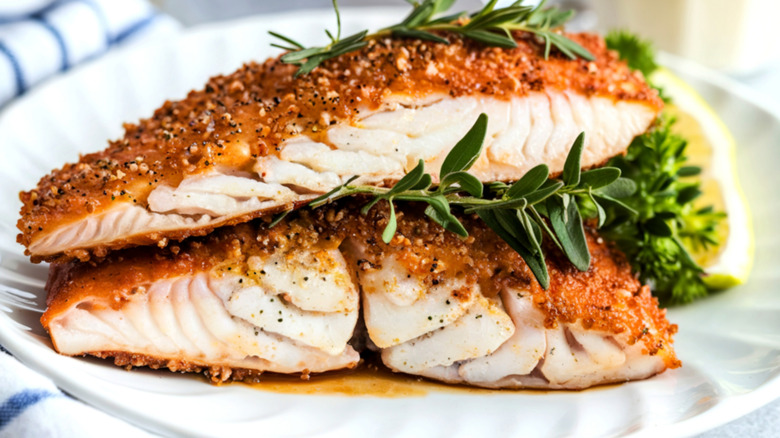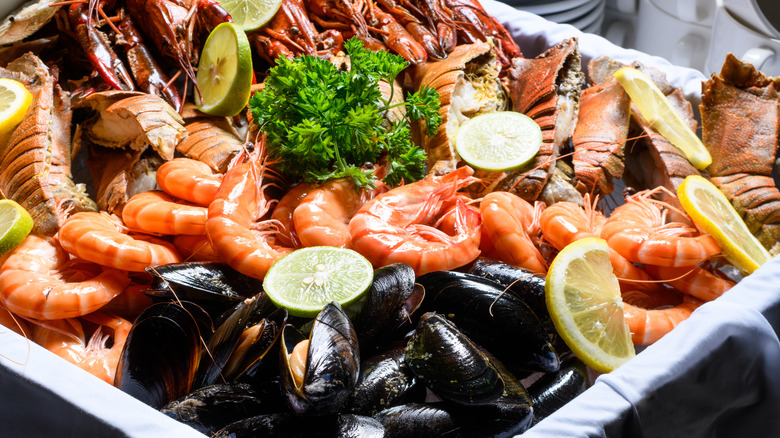Meats That Are About To Get More Expensive
Plenty of grocery staples are going to start costing more in 2025 thanks to inflation, supply chain disruptions, and the implementation of President Donald Trump's proposed trade tariffs. Meat is one grocery item that's frequently imported from other nations, and as a result, consumers will see its cost rise as these tariffs take effect. From poultry to veal, meat across the board is about to get more expensive — even Costco foods like beef and seafood will likely start to see price changes.
While these tariffs, which charge international companies to export goods to the U.S., will theoretically raise the nation's revenue and stimulate domestic production, the reality is that this higher cost of offshore trade will likely get passed onto consumers through elevated in-store and online prices. In some cases, countries have responded with retaliatory tariffs. China, for example, announced a tariff boost from 34% to 84% (and eventually up to 125%) on imported U.S. goods, though fortunately, both countries agreed in May to significantly slash these respective increases, if only for a three-month period.
While tariffs are not the direct reason for every jump in price across the industry, they may prompt ripple effects when combined with other economic and environmental factors. Here are the meats worth keeping an eye on.
Beef
Certain types of beef, like wagyu and Kobe (a variety of wagyu), are known to be expensive. But more affordable varieties, like ground beef and sirloin steak, have long been meal staples for those watching their spending, as they're filling, high in protein, and generally quite accessible. In the coming months, however, these go-to foods might pose a budgeting issue for the average American consumer.
Since the start of the pandemic, supply chain issues have already boosted the cost of bovine meat, and while that particular industry challenge has eased somewhat, new economic difficulties are once again threatening to place this ingredient out of reach for some. The domestic cattle population, which currently sits at around 86 million, is the lowest it's been since 1951, according to USDA data. Imported beef from countries like Canada and Mexico helps fill out the U.S. supply — a boon during summer grilling season when U.S. demand for beef is at its peak — but 25% tariffs on Mexican and Canadian imports may result in higher costs getting passed onto consumers. Additionally, in May 2025, President Donald Trump suspended Mexican beef imports for 15 days following an outbreak of screwworm among the country's cattle, further straining trade relations.
According to data from the St. Louis Federal Reserve Bank, the average price for a pound of beef in April 2025 was $5.80 — an increase of nearly 13% from the previous year (via USA Today). Over the course of 2025, the USDA forecasts that beef prices will continue to rise at least 6.3%.
Veal
Veal is essentially a younger, more expensive version of beef. It comes from male calves, specifically those that are under 18 weeks old. Like lamb, there's plenty of controversy surrounding the production and consumption of veal, but it remains a staple on restaurant menus and in butcher shops across the country.
Like beef prices, the cost of veal is expected to rise at least 6.3% over the course of 2025, according to USDA data. The agency states that "tight supplies and continued consumer demand" are the cause of increases across the bovine meat industry, and one reason for this tight supply is consistent drought. According to the National Integrated Drought Information System (NIDIS), the latter half of 2024 set drought records, with all states experiencing some level of dryness except for Alaska and Kentucky. Since some domestic beef producers grow their own cattle feed, lack of precipitation often leads to less food and smaller herds.
A swell of inflation in January 2025 and proposed tariffs affecting U.S.-Mexico trade will no doubt also play a role in elevated veal costs. As Jason Walker, co-owner of California's StarWalker Organic Farms, told The New York Post in February 2025, current record-high prices at cattle auctions are great, "If you're selling cattle ... If you're buying cattle, it's not a great thing." As more ranchers attempt to sell, their herd sizes continue to shrink, thus perpetuating the cycle.
Pork
As beef prices rise, many consumers may start opting for more affordable proteins like pork. There are plenty of ground pork recipes you can make on repeat to get as much value as possible out of this ingredient, but it's still not immune to the effects of economic upheaval. Per USDA data, pork prices will likely rise at least 1.8% over the course of the year, and while this may seem negligible considering larger projected increases like those affecting beef, people grocery shopping on a budget are likely to feel the squeeze regardless.
Increased demand due to seasonal shifts in consumer behavior may also impact prices. In May 2025, economist David Anderson, Ph.D. told National Hog Farmer that the meat industry gets "a seasonal run going into Memorial Day" and that "demand during grilling season can influence prices across most everything beef, poultry, and pork." Furthermore, data shared by the USDA in April indicates that domestic pork production in 2025 will equal just 28.1 billion pounds — a 350 million-pound drop from March projections. Dips in production paired with increasing demand may signal further price hikes.
As a result of the ongoing trade war, pork exported from the U.S. into China also faces a potential 81% tariff, which may threaten profit margins and supply in the American hog industry. While tensions appear to be easing as certain tariffs are slashed, market uncertainty remains.
Chicken
While some consumers may find themselves relying more heavily on chicken as an affordable protein source as red meat prices continue to rise, that affordability may only be relative. USDA data indicates that throughout 2025, the price of chicken will likely increase by about 1%. This isn't a huge margin, but as other grocery staples also grow more costly, higher chicken prices will only contribute to financial strain for many shoppers.
Both labor shortages and the increased price of feed have raised overall production costs in the poultry industry, and these increases will likely become evident throughout the year as chicken products receive heftier price tags. While tariffs won't necessarily factor into these increases directly, this was a possibility when China's tariffs on U.S. poultry exports from companies like Tyson Foods and Pilgrim's Pride were on the rise back in April. Regardless of direct tariff impact, American consumers' increased reliance on this bird is hard to disentangle from rising beef costs.
In the short term, chicken prices may also rise to meet demand leading up to summer occasions like Memorial Day. Beef is the most popular meat to grill over the holiday weekend according to data shared by GV Wire in 2024: On average, 34% of people named steak as their meat of choice for Memorial Day that year, and while burgers came in second with 19%, chicken managed to snag third place with a respectable 18% (beating out ribs with 11% and hot dogs with just 5%).
Turkey
Much like chicken, turkey is another type of poultry that will see price increases throughout 2025. The USDA's 101st Annual Agricultural Outlook Forum highlighted "declines in turkey production" in 2024, resulting from decreased prices over the two previous years. In turn, this reduced production — now forecast to decrease 3% in 2025 for an annual total of 4.97 billion pounds — is slated to drive up turkey prices during the year. The agency also noted declines in turkey exports during 2024, which may further strain availability.
Furthermore, in late April 2025, the Veterinary and Food Administration confirmed the presence of avian influenza in certain turkey products imported from Denmark. As health authorities continue attempts to quell a similar virus in chickens — the same one driving up the cost of eggs nationwide — the U.S. turkey industry might experience changes in supply and, as a result, price.
As far as tariffs are concerned, turkey does not appear subject to the same rise in costs Americans are seeing for other protein staples. Much U.S. turkey is produced domestically, and in fact, according to USDA data, chicken is the more commonly imported poultry. For example, between May 4 and 10, 2025, 367 metric tons of turkey were imported to the U.S. exclusively from Canada, whereas chicken imports from Canada, Chile, and Mexico clocked in at 1,599 metric tons over the same period. With President Donald Trump's tariffs on Canadian imports in effect, however, turkey prices may continue to fluctuate.
Fish
The seafood market was seemingly one of the first to see effects from President Donald Trump's tariffs. By mid-April 2025, U.S. fish vendors were noticing price increases across the industry, especially on products from places like Canada and Brazil. Imports from countries across Asia, such as China, Vietnam, India, and Indonesia, are also likely to see price changes. Steep tariffs on items like cod, halibut, and swordfish have upended production for many vendors, who must now seek out alternative trade partners to keep consumer prices in check.
Norway, a major salmon supplier for the U.S., has faced a 15% tariff since April. According to SalmonBusiness, this could drive up prices by $7 or more per fish. Demand for domestic seafood options will likely rise as these tariffs take effect, and this in turn could further impact prices as well as local supply. According to April 2025 data from Expana, salmon fillets exported from Europe saw a 12% price increase over the course of a week, while Chilean fillet exports rose 6% over the same period. The time-sensitive nature of transporting non-frozen fish may also exacerbate these industry changes. Prices will no doubt continue to fluctuate as trade negotiations continue — especially since about 85% of seafood in the U.S. is imported, according to WFAE.
Shellfish
Much like fish such as salmon and halibut, shellfish is another type of seafood that will see major price shifts as a result of tariffs. Shrimp, lobster, crab, and scallops are just some of the items in this category that have already seen price surges as international vendors navigate new trade limitations.
As an example, let's take a look at the shrimp industry, which will see tariffs ranging from 10% to 32%. One reason these increases will notably affect shoppers is that most of the shrimp Americans consume annually — over 90%, according to The New York Times — is imported from countries like India, Indonesia, Ecuador, and Vietnam. While Ecuador is only subject to 10% tariffs as of this writing, the other countries listed are (or initially were) subject to much higher rates. Indonesia, for example, could see tariffs as high as 32% under President Donald Trump's plan, thus making consumer goods imported from the island nation that much more expensive. Vietnam, meanwhile, would have been subject to 46% tariffs before negotiations slashed this number to 10%.
Not everyone in the shellfish industry is pessimistic about these changes, however. The East Coast Shellfish Growers Association expressed support for higher import tariffs in a March 2025 letter to an assistant U.S. trade representative, citing "substantial government subsidies and reduced regulatory costs" as two major advantages offshore competitors have over U.S. shellfish farms — advantages the group believes tariffs would remedy. Other entities like Get Maine Lobster emphasize that domestic shellfish options will remain tariff-free amid a shifting international market.
